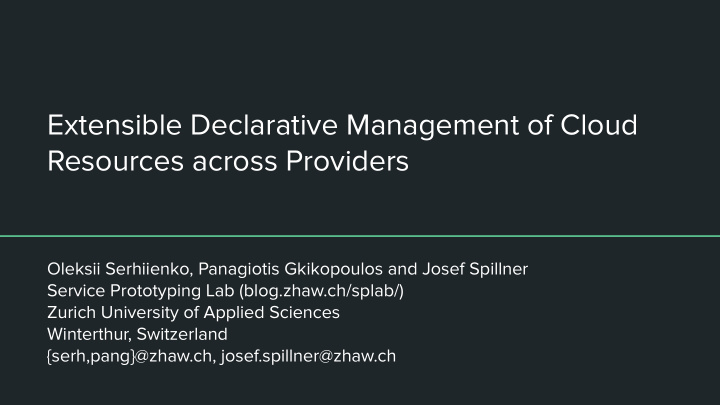



Extensible Declarative Management of Cloud Resources across Providers Oleksii Serhiienko, Panagiotis Gkikopoulos and Josef Spillner Service Prototyping Lab (blog.zhaw.ch/splab/) Zurich University of Applied Sciences Winterthur, Switzerland {serh,pang}@zhaw.ch, josef.spillner@zhaw.ch
Agenda 1. Resource management in multicloud environments 2. Tag-based management in current practice 3. Challenges of using tags in a multicloud environment 4. Universal Connector (UC) concept 5. Implementation of the Multitag connector 6. Demo screencast 7. One step beyond: multiple UCs and the UC broker 8. Questions
Multicloud Environments Utilisation of resources from multiple cloud providers within the same project Image source: Avi networks
Multicloud management Management solutions with a multicloud abstraction (CMPs) are on the rise These allow getting an overview of the project and simplifying the financial side of management There is yet to be a solution for managing a large number of resources on multiple providers without individually interacting with each provider
Resource management using tags Grouping resources using tags in not a new concept Every cloud provider offers their own implementation of tag-based management for their platform These individual implementations only apply to the specific provider Multi or cross cloud tagging is yet to be offered by a multi-cloud management platform
Challenges of multi-cloud or cross-cloud tagging (1) The implementation of tagging differs from provider to provider ● number and form of tags allowed ● interface used when applying the tags, especially when tagging a group of resources at once
Challenges of multi-cloud or cross-cloud tagging (2) Main differences in the tagging implementation between AWS, Google Cloud Platform and Azure The difference in the tagging interface implementation is the biggest technical hurdle to overcome
Challenges of multi-cloud or cross-cloud tagging (3) These differences make a management workflow involving resources from different cloud providers problematic If the same tag is applied to resources on different providers it must apply to all sets of rules, and needs to be applied with the provider’s own interface That increases the factors an administrator needs to consider when managing resources, and the probability of human error
The Universal Connector concept A service that connects management capabilities of different cloud providers Multitag Connector capabilities: ● Automates tagging resources across all supported providers ● Allows cross-cloud resource management by tag
Automated rule-based tagging (1) rule1 : type : instance providers : aws Rules are based on resource conditions : condition1 : type, provider and a set of eg. ImageId: instance1 user-defined conditions based InstanceType : t12 . micro condition2 : on the resource’s metadata CpuOptions . CoreCount: 12 tags : aim: demo
Automated rule-based tagging (2) The tags are checked against the constraints of all providers, to ensure the resources can be managed in cross-cloud groups without the possibility of error Tags can also be applied manually to a list of resources independent of provider for more fine-grained control
Cross-cloud management by tag Standard management operations on resources across different providers, grouped by tags How our implementation differs from similar capabilities in standard CMPs? The resources can be grouped together by tag and managed at once even if they are deployed on different providers
Universal Connector Implementation We implemented the Multitag Universal Connector (UC) as a middleware service exposed through a REST API.
Cross-cloud tag-based management using FaaS Using FaaS for the management functionality grants us: ● a high amount of extensibility and flexibility ensuring that the core middleware itself remains lightweight ●
Multiple UCs and the UC broker A simple broker service was also developed to manage multiple UCs It would be possible to extend the capabilities beyond declarative management, eg with a billing UC The broker could be further developed to also handle security, credential storage and caching
Conclusion We presented a solution for extensible declarative resource management in a multi-cloud environment based on a connector service with FaaS-based satellite functions to implement the management functionality Service Prototyping Lab: Aiming to contribute to cloud application engineering and tools for data and stream processing platforms
Thank you for your attention! Any questions?
Recommend
More recommend